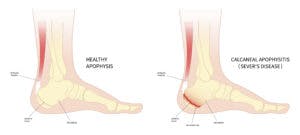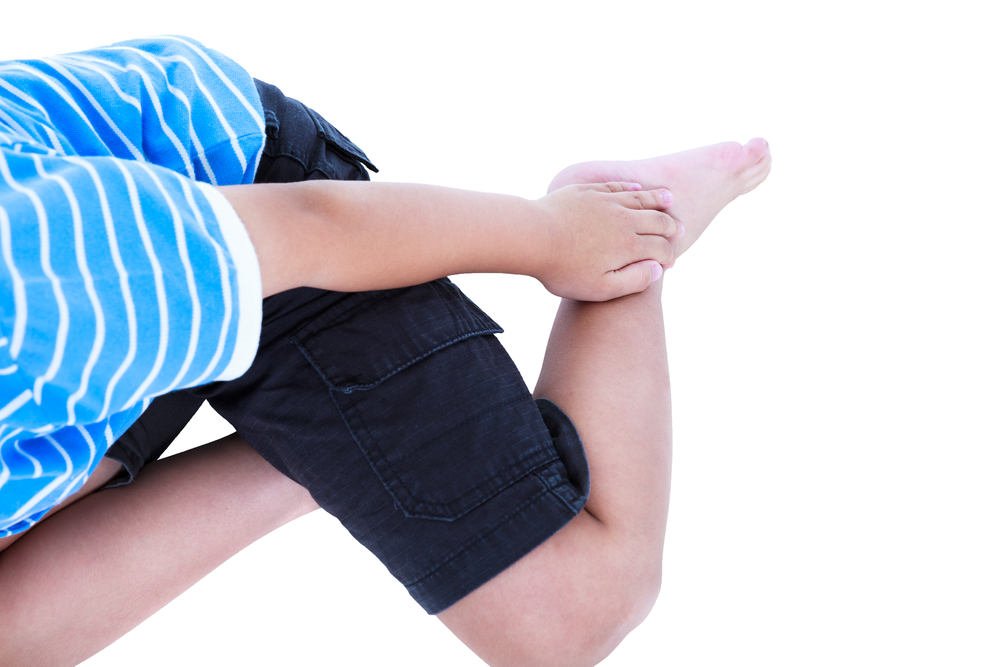Is your son or daughter complaining of heel pain? Sever’s Disease is the most common cause of heel pain in children 15 and under. It usually occurs around your child’s growth spurt. The disorder is due to repetitive stress from running or jumping. It is common in children who play basketball, soccer, or run track. There are 3 proven ways to decrease pain from Sever’s Disease.
What is Sever Disease?
Sever disease is an overuse injury due to repetitive strain caused by the force of the strong Achilles tendon. This leads to irritation and injury to the soft growth plate in the heel. The force on the heel is increased after periods of rapid growth and increased activity.

Contributing factors include increased or excessive sports activity (especially sports requiring repetitive running and jumping), heel cord tightness, weak ankle muscles, poorly cushioned or worn-out athletic shoes, and running on hard surfaces.
Proven Treatments for Sever Disease
A 2016 study published in the Journal of Pediatric Orthopaedics looked at 3 treatments for Sever’s Disease. 101 children between the ages of 8 and 15 were randomly placed into 1 of 3 groups: 1) Wait and see, 2) Heel lift, and 3) Eccentric exercise.
After 6 weeks, all 3 groups showed significant improvement in pain. However, the heel lift group and eccentric exercise group improved their function more than simply waiting for the pain to resolve on its own. This study proves that an active approach is best to overcome pain and limited function associated with Sever’s Disease.
Below are more details about the 3 different treatment approaches for Sever’s Disease.
Waiting for the Pain to Resolve on Its Own
This approach involves rest and periods of inactivity. This usually means holding your child out of sports practice and competition until symptoms subside. This usually takes 6 to 8 weeks. Of course, this is not the preferred course of action.
In fact, we strongly recommend against a wait-and-see approach. This leads to physical consequences like muscle disuse, loss of aerobic fitness, and general health. Also, keeping your child out of sports has significant mental, emotional, and social consequences.
Heel Lift Shoe Inserts

Small shoe inserts that elevate the heel decrease forces on the growth plate. Most children with Sever’s Disease have tight heel cords (Achilles tendons). Heel lifts help to keep the back of the foot elevated which shortens the Achilles tendon and calf muscle. This decreases the load on the tendon so it doesn’t stretch as much as when your child runs or jumps.
We recommend using a heel lift early in the course of rehabilitation. You can purchase these through Amazon. Elevating the heel leads to significant pain relief and allows your child to continue playing sports. However, this is only a short-term fix. Regular exercises are needed for a fast and full recovery from Sever’s Disease.
Exercises for Sever’s Disease
Heel cord stretching exercises are essential to lengthen your child’s Achilles tendon and reduce the load on the growth plate. Stretches should be done on both legs 3 times every day. Have your child hold each stretch for at least 30 seconds and do 3 repetitions each time.
Eccentric loading exercises not only lengthen tight heel cords. They also improve tendon and muscle strength. This leads to a more complete recovery with less risk for re-injury. We recommend doing heel drop exercises once per day. Have your child do 3 sets of 12 to 15 repetitions each day. Expect some pain when first starting out. If pain persists, be sure to bring your child in to see a physical therapist.
See a Physical Therapist for Sever’s Disease
Getting a heel lift insert and starting a stretching program is an excellent start for overcoming Sever’s Disease. However, many children have trouble staying consistent with their exercises on their own. Working with a physical therapist keeps your child on track. Also, physical therapists address other common contributing factors like your child’s sneaker fit, running mechanics, and jumping mechanics.
Contact our office to schedule an initial evaluation with a physical therapist. The doctors of physical therapy at BSR have been helping people in Southern Ocean County feel better and get back to sports since 2007.

